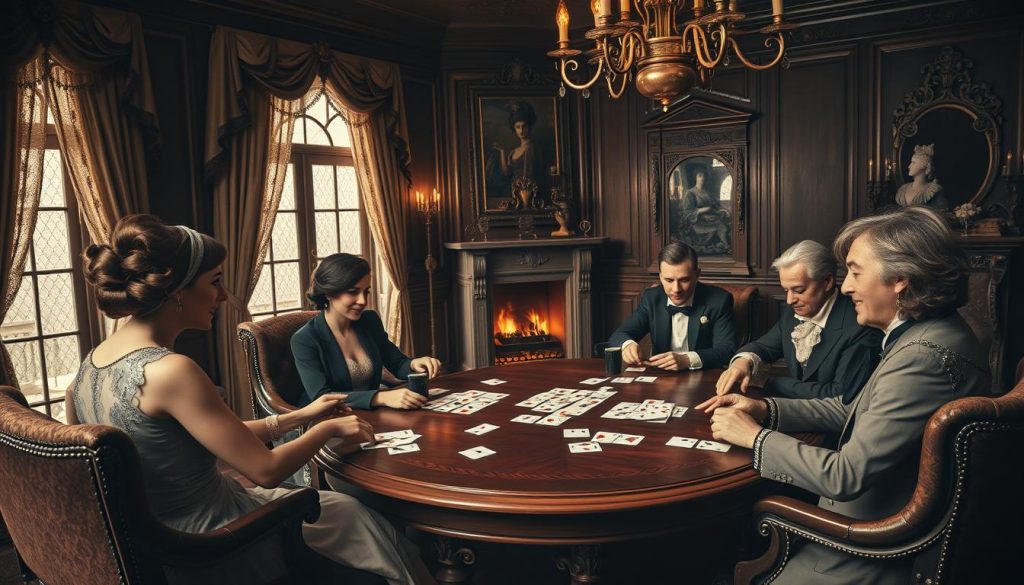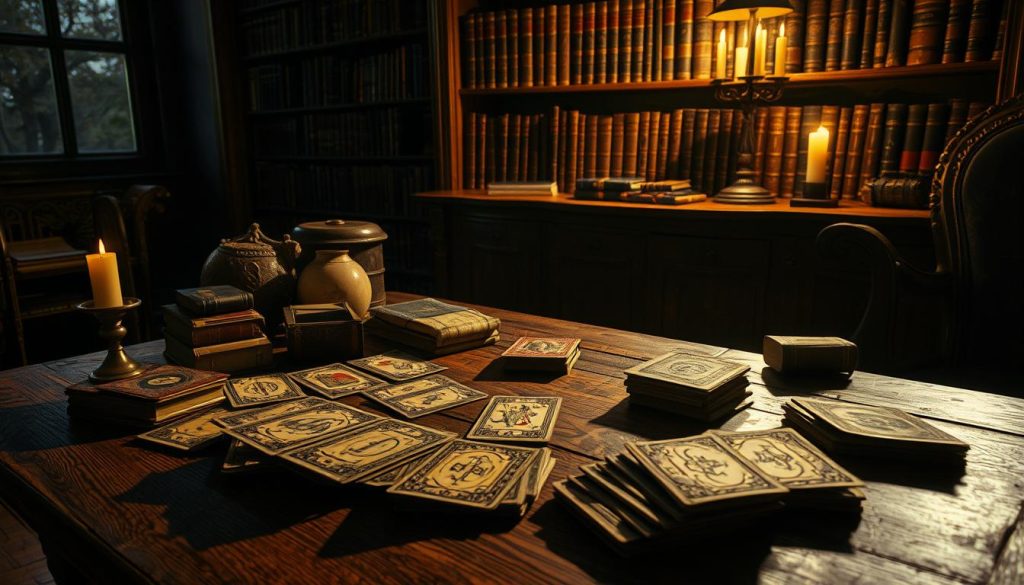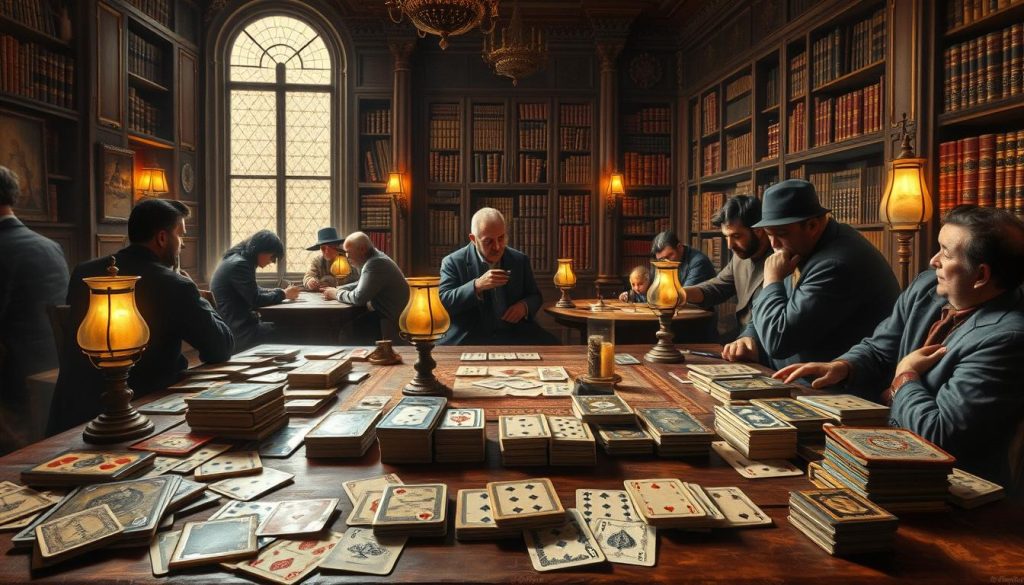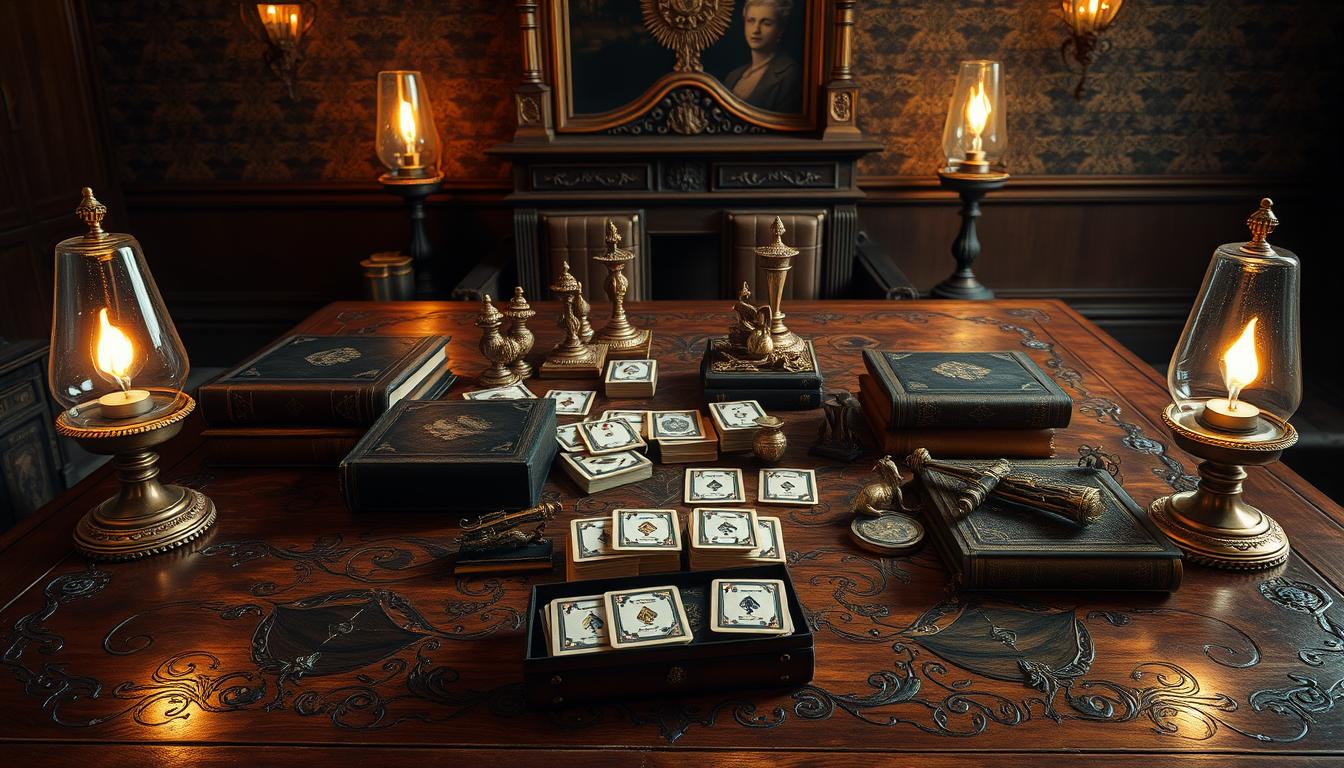Card games have been a big part of human history. They changed how we interact and experience culture over the years. These games are more than fun—they show us how people connect.
The history of playing cards is full of stories. They started in places like China and Persia. As they moved around the world, they changed and grew. Each deck of cards showed the culture of the people who made and played them.
Card games were more than just fun. They helped people from different backgrounds come together. They sparked conversations and created shared moments. These games were played everywhere, from markets to royal courts, bringing people together.
We will explore the world of traditional card games together. We’ll learn about their beginnings, how they changed things, and their lasting impact. Join us as we travel back in time and see how these games shaped our interactions over the years.
The Origins of Playing Cards: From Ancient China to Medieval Europe
Playing cards have a long and exciting history. They started in ancient China, where they were more than just games. They were art and symbols of culture.
In ancient China, cards were not just for fun. They had deep meanings. Designs showed ideas, social order, and spiritual views.
Early Chinese Playing Card Characteristics
- Handcrafted with intricate designs
- Used for entertainment and divination
- Represented social and spiritual concepts
- Created using paper and wood materials
The Silk Road’s Transformative Impact
The Silk Road was key in spreading these cards. Merchants took them to new places. This led to big changes in card design and how they were played.
European Card Game Innovations
In Europe, cards got a new look. Craftsmen made them their own. They created new suits and rules that we still use today.
- Developed four-suit system
- Created standardized card sizes
- Introduced complex game rules
- Expanded card manufacturing techniques
The story of playing cards shows how sharing ideas can change things. It shows how simple items can connect us over time and space.
Historical Card Games That Transformed Social Gatherings

Social card games have brought people together for centuries. They made game nights more than just fun. They were key to connecting communities across time and social levels.
In medieval taverns and Victorian parlors, card games were big. People played games that needed strategy, wit, and talking. These games were not just for fun. They were ways to build friendships and show off smarts.
- Whist: A popular 18th-century game that demanded skill and communication
- Piquet: A strategic French card game favored by nobility
- Loo: A social gambling game that created exciting group dynamics
Different groups had their own card game traditions. Rich families had fancy game nights with complex rules. Working-class folks played simpler games that focused on quick thinking and friendship.
Card games did more than entertain. They helped people meet, fall in love, and show off their social skills. Players learned how to negotiate, plan, and be polite through these games.
These games changed how we interact today. They showed that games can bring people together, no matter who they are. They helped create lasting bonds between people from all walks of life.
Royal Courts and Their Favorite Card Games Through History
Royal card games were more than fun for the rich. They were a way for kings, nobles, and courtiers to connect. These games showed the complex social lives and cultural trades of European kingdoms.
Card games were key in royal courts for socializing. They showed off smart thinking, wealth, and status. The designs of these cards got more detailed, showing off the art and culture of each royal family.
French Court’s Influence on Modern Card Design
The French royal court changed playing cards into art. They made modern card designs better with:
- Elegant court card designs
- Standard suit symbols
- Beautiful decorations
Tudor England’s Popular Card Games
Monarchs like Henry VIII loved card games in Tudor England. These games were fun and helped with diplomacy. Some favorite games were:
- Primero – A complex game for betting
- Gleek – A game for three players
- Noddy – A game of strategy and matching
Spanish Royal Gaming Traditions
Spanish royal courts had their own special card games. These games showed off local art and complex rules. They were a unique way to express culture through gaming.
Ancient Gambling Cards: From Tarot to Traditional Games

Historical gambling cards have a rich and fascinating legacy. They stretch across continents and centuries. Tarot history shows these cards were once used for betting, not just fortune-telling.
Early gamblers turned simple card decks into complex games. These games captivated players from different cultures.
The origins of ancient betting games are fascinating. Players risked valuable things on card games. This created intense social interactions and economic exchanges.
Traditional gambling cards were more than game pieces. They showed complex social dynamics and cultural practices.
- Tarot cards originally emerged in 15th-century Italy
- Gambling games spread rapidly through trade routes
- Different regions developed unique card playing traditions
Ancient betting games showed the social structures of their time. Both wealthy and common people enjoyed card games. These cards offered entertainment, social connection, and sometimes big wins.
As card games evolved, they got more complex. This change marked a big shift in how we enjoy leisure activities.
- Mediterranean regions pioneered complex gambling techniques
- Asian cultures developed sophisticated card game strategies
- European courts refined gambling card traditions
The legacy of these games still shapes modern casino entertainment. Knowing the history of these cards helps us understand our love for games of chance.
Evolution of Playing Card Designs and Symbols
Playing cards have changed a lot over time. They show how cultures and art have evolved. These small cards tell stories of human creativity and how we connect with each other.
Playing cards’ designs have been shaped by many cultures. The meanings of card suits vary, making each suit special. They are more than just game pieces.
The Four Suits: Cultural Roots and Symbolism
Card suit meanings come from different cultures. Each place had its own way of seeing suits:
- French decks feature hearts, diamonds, clubs, and spades
- Italian decks have cups, coins, swords, and batons
- German decks show hearts, bells, acorns, and leaves
Court Cards and Their Historical Representatives
Court card history is full of interesting facts. These cards often showed royalty, warriors, and key figures. They turned simple cards into tiny stories of history.
Regional Variations in Card Design
Playing cards from different places are very diverse. From detailed Persian designs to simple Japanese cards, each culture added its own touch. This makes a beautiful mix of art that keeps changing.
These changes show that playing cards are more than games. They are a way to see human culture and creativity.
Maritime Trading and the Global Spread of Card Games
Sailors and merchants spread card games all over the world. They played games on long voyages to pass time and bond. These games became a way to share cultures through cards.
Decks of cards traveled far and wide. Merchants brought games from their homes to new places. Sailors learned and mixed games from different lands, creating a vast network of traditions.
- Sailors shared card games during maritime expeditions
- Trading ships carried decks across continents
- Ports became melting pots of gaming traditions
As Europe expanded its colonies, card games spread further. Traders took their games to Asia, Africa, and the Americas. Local people adapted these games, making them their own with unique twists.
By the 18th century, card games were a common language of fun. They connected people far apart through shared fun. The sea turned simple cards into powerful tools for sharing cultures.
Famous Historical Figures and Their Card Game Legacy
Card games were more than fun for famous people. They showed their strategic thinking and how they interacted with others. Historical figures used cards to show off their smarts and connect with others.
Looking into the card games of famous people gives us interesting insights. These games were not just for fun. They were a way to show off one’s personality and skills.
Napoleon’s Strategic Card Gameplay
Napoleon loved card games for more than just fun. His games showed his strategic thinking. He used cards to:
- Work on his tactical thinking
- Practice making quick decisions
- Challenge his friends mentally
Benjamin Franklin’s Card Playing Passion
Benjamin Franklin’s card games were also interesting. As a smart and diplomatic person, he saw cards as more than fun. His card playing showed his:
- Curiosity and love for learning
- Ability to make friends
- Understanding of math
Catherine the Great’s Royal Gaming Tables
Catherine the Great made card games into fancy social events. Her tables were where people talked politics, made deals, and showed off their culture.
Traditional Card Games That Survived Centuries

Some card games have been loved for many years. They are timeless fun that crosses cultural lines. These games still bring people together, showing the lasting charm of traditional play.
Games like Whist, Piquet, and Solitaire are great examples. They have stayed popular for centuries. Their lasting appeal comes from:
- Simple yet strategic gameplay mechanics
- Easy-to-learn rules that challenge players’ thinking
- Social interaction opportunities
- Adaptability to different skill levels
The rules of these classic games show their ability to entertain and challenge. Whist, for example, evolved into modern bridge. This shows how traditional games can change while keeping their core strategies.
Players love these games for their history and brain challenge. They are enjoyed in family settings and competitive games. These card games keep connecting card lovers across generations.
From royal courts to today’s living rooms, these games show the joy of strategy and social play. They are a lasting part of our entertainment.
The Impact of Historical Card Games on Modern Gaming Culture
Historical card games have deeply influenced modern gaming culture. They have left a lasting legacy that inspires both game developers and players. These games have evolved over time, blending traditional strategies with new digital platforms.
Modern game development owes a lot to classic card game strategies. Designers like Sid Meier and Rob Pardo have been inspired by these games. They’ve added complex decision-making and strategic thinking to their designs.
Poker tournaments and games like Hearthstone show how these old gaming principles are still alive. They keep players engaged and interested.
The evolution of gaming culture is tied to the social aspects of old card games. Games today offer interactive multiplayer experiences and deep strategy. This is thanks to the influence of historical card games.
Card games have always brought people together, from European salons to today’s esports arenas. Their appeal comes from a mix of skill, chance, and social interaction. This shows how these games remain loved across generations.

